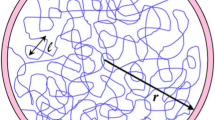Abstract
With good confinement and relatively high beta (up to 40%), the spherical tokamak could be a suitable magnetized target. To illustrate this potential, the theoretical fusion yield from compressing a spherical tokamak adiabatically to fusion conditions is calculated. While it is found that the large amount of energy stored in the compressed toroidal field constrains the potential energy gain, a system can be designed to produce significant useful output by directly recovering a large fraction of the compression energy. With 80% energy recovery, an example system using 140 MJ of pressurized gas to compress the spherical tokamak plasma within a 2 m radius liquid metal flux conserver can produce a fusion yield of 140 MJ and a net output of 40 MJ per pulse. At ~ 1 Hz this would produce 40 MWelectric.


Similar content being viewed by others
References
R.L. Miller, R.A. Krakowski, Assessment of the Slowly-Imploding Liner (LINUS) Fusion Reactor Concept, in 4th ANS Topical Meeting on the Technology of Nuclear Fusion (1980)
P.J. Turchi, A.L. Cooper, R.D. Ford, D.J. Jenkins, R.L Burton, Review of the NRL Liner Implosion Program, in MegaGauss Physics and Technology (Plenum Press, New York, London, 1980), p. 375-386
D.D. Ryutov, R.E. Siemon, Magnetized plasma configurations for fast liner implosions: a variety of possibilities. Comments Mod. Phys. 2C, 185–201 (2001)
T.R. Jarboe, Formation and steady-state sustainment of a tokamak by coaxial helicity injection. Fusion Technol. 15(1), 7–11 (1989)
R. Siemon, I. Lindemuth, K. Schoenberg, Why magnetized target fusion offers a low-cost development path for fusion energy. Comments Plasma Phys. Controll. Fusion 18, 363–386 (1997)
M. Porkolab, High performance discharges and capabilities in alcator C-Mod. J. Fusion Energ. 15, 169 (1996). https://doi.org/10.1007/BF02266931
M. Greenwald, Density limits in toroidal plasmas. Plasma Phys. Control. Fusion 44, R27 (2002)
L.C. Bernard, F.J. Helton, R.W. Moore, T.N. Todd, MHD beta limits: scaling laws and comparison with Doublet III data. Nucl. Fusion 23, 1475 (1983)
http://www.iaea.org/inis/collection/NCLCollectionStore/_Public/16/028/16028204.pdf top of p.2
R.J. La Haye et al., High beta tokamak operation in DIII-D limited at low density/collisionality by resistive tearing modes. Nucl. Fusion 37, 397 (1997)
Author information
Authors and Affiliations
Corresponding author
Rights and permissions
About this article
Cite this article
Laberge, M. Magnetized Target Fusion with a Spherical Tokamak. J Fusion Energ 38, 199–203 (2019). https://doi.org/10.1007/s10894-018-0180-3
Published:
Issue Date:
DOI: https://doi.org/10.1007/s10894-018-0180-3




